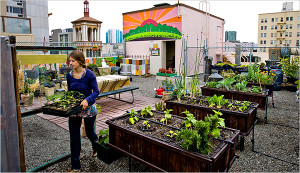by AL SHAY, Statesman Journal, January 2, 2014

Maya Donelson tends the rooftop garden of Glide Memorial Church in San Francisco
Photo: Peter DaSilva for The New York Times
Source: www.nytimes.com
So many of our horticulture students at Oregon State University are enthralled with the thought of becoming organic farmers despite the fact there seems to be an overabundance in the Willamette Valley already.
I encourage them to look at the new urban environment, you know the one that covers only 2 to 3 percent of the earth’s surface but consumes nearly 70 percent of its resources. This particular model also predicts that the urban environment is poised to house and accommodate the needs of seven out of every 10 inhabitants by 2050. I recently examined a rooftop gardening operation on the east coast and was simply amazed at what they are doing.
I was thumbing my way through the 355 page Whole Seed catalog from Baker Creek Heirloom Seeds when an article entitled the Brooklyn Grange Farm caught my attention. It is the largest rooftop farming operation in America. They have two sites, one at the old Brooklyn navy yard and one in Queens, NY. Together there is a combined area of 108,000 square feet. This is nearly 2½ acres from which they produce nearly 20,000 pounds of produce per acre.
This is rather astounding in terms of production, especially when you look at the available rooftop space in New York or any other major metropolitan environment. Now, green roofs in Portland and most cities still are primarily driven by storm-water mitigation, slowing down the flow of water from a green roof so as to allow the city’s storm-water sewer infrastructure to not be overwhelmed.
Imagine now that that same benefit is derived from a plant palette that can produce food. That’s exactly what they have done in this operation. Gardens reduce the urban heat island effect by transpiring water, which absorbs heat in the process. Schoolchildren have their first opportunity to see where food comes from and help maintain the garden. Urban bee and chicken production also is taking place on rooftops. Most exciting I think is the opportunity to start farming without having to pay the exorbitant prices for terrestrial farmland, customers are literally at your doorstop and major delivery costs are eliminated.
Al Shay is a consulting horticulturist and instructor at OSU.